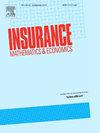Avoiding a longevity catastrophe: Harnessing longevity indices to mitigate individual, institutional and systemic longevity risks
IF 2.2
2区 经济学
Q2 ECONOMICS
引用次数: 0
Abstract
This paper considers the financial implications of an extreme increase in life expectancy for: (i) individuals with defined contribution pension plans and other forms of retirement savings; (ii) institutions such as defined benefit pension plans, insurance companies and reinsurers; and (iii) the financial system and economy as a whole. An extreme longevity scenario, as the IMF first acknowledged in 2006, is a long-term systemic risk that could impair the operation of the financial system with severe ramifications for the global economy. It also poses a significant risk to individuals who might live beyond the time that their retirement savings can support them. This paper explores one under-utilised way to mitigate these risks, viz., longevity index hedges, which can transfer longevity risk simply, rapidly and transparently away from where it is concentrated to a much broader set of organisations with appropriate levels of risk capital. For the market in these index hedges to grow requires a shared understanding of the hedges and their risk reduction potential by the insurance industry and regulators.
避免长寿灾难:利用长寿指数来减轻个人、机构和系统的长寿风险
本文考虑了预期寿命极端增长对以下方面的财务影响:(i)拥有固定缴款养老金计划和其他形式退休储蓄的个人;(ii)固定收益养老金计划、保险公司和再保险公司等机构;(三)金融体系和整个经济。正如国际货币基金组织在2006年首次承认的那样,一种极端的长寿情景是一种长期的系统性风险,它可能损害金融体系的运行,对全球经济产生严重影响。这也给那些可能活得超过退休储蓄所能支撑的时间的人带来了重大风险。本文探讨了一种未充分利用的方法来减轻这些风险,即长寿指数套期保值,它可以简单,快速和透明地将长寿风险从集中的地方转移到具有适当风险资本水平的更广泛的组织。要使这些指数对冲市场增长,保险业和监管机构必须对对冲及其降低风险的潜力有共同的理解。
本文章由计算机程序翻译,如有差异,请以英文原文为准。
求助全文
约1分钟内获得全文
求助全文
来源期刊

Insurance Mathematics & Economics
管理科学-数学跨学科应用
CiteScore
3.40
自引率
15.80%
发文量
90
审稿时长
17.3 weeks
期刊介绍:
Insurance: Mathematics and Economics publishes leading research spanning all fields of actuarial science research. It appears six times per year and is the largest journal in actuarial science research around the world.
Insurance: Mathematics and Economics is an international academic journal that aims to strengthen the communication between individuals and groups who develop and apply research results in actuarial science. The journal feels a particular obligation to facilitate closer cooperation between those who conduct research in insurance mathematics and quantitative insurance economics, and practicing actuaries who are interested in the implementation of the results. To this purpose, Insurance: Mathematics and Economics publishes high-quality articles of broad international interest, concerned with either the theory of insurance mathematics and quantitative insurance economics or the inventive application of it, including empirical or experimental results. Articles that combine several of these aspects are particularly considered.
 求助内容:
求助内容: 应助结果提醒方式:
应助结果提醒方式:


